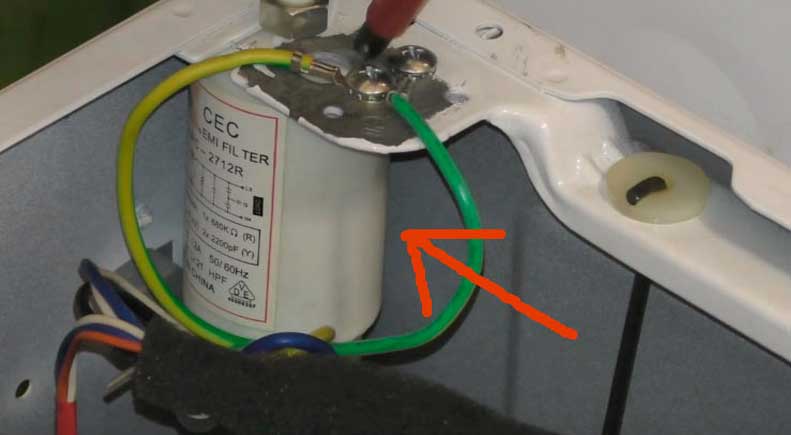Where is the power filter in the washing machine?

All automatic washing machines are equipped with a network filter. The device blocks impulse overvoltage in the network, thereby protecting the equipment from breakdown. If the interference suppression element fails, the washing machine does not turn on.
Users need to know where the network filter is located. Knowing the location of the element, if necessary, it will be possible to perform its diagnostics. We will tell you where to look for the interference suppression device, how to check and restore it.
Where is this part attached?
So where is this little detail hidden in washing machines? Most washing machines have a noise filter located at the base of the power cord. It is very easy to find – just remove the top panel of the washing machine and find the place where the power cable enters the body.
A network filter is a small plastic part with a board inside. The shape of the part can be different - from a barrel to a box. Finding the device in this case will not be difficult.
In some washing machines, the role of a network filter is performed by a separate semiconductor on the control board. In this case, it is better to entrust the diagnostics and repair of the interference suppression device to specialists. It will be difficult for a beginner to understand the elements on the electronic module of the washing machine.
Why do they put such filters in machines?
An interference suppression device is provided in each washing machine. The filter protects the washing machine – it neutralizes all frequencies above and below 50 Hz. This prevents voltage surges in the electrical network from damaging the equipment.
When the interference filter detects a critical voltage level, it will immediately turn off the washing machine. The cycle will be interrupted at any stage. If the detected failure was short and insignificant, this will only lead to the waste of the FPS capacitors. If the surge is strong enough, the protective device will burn out.
The interference filter performs an important function. Without it, the slightest fluctuation in the power grid could damage the control module, engine, drain pump. Asynchronous motors most often suffer from voltage drops - they stop working, the current continues to flow to the stator winding, which ends with the motor burning out.
The FPS also serves to protect other devices. Switching washing stages, starting the engine - all this is accompanied by a change in direct current in the network. If it were not for the interference filter, this would threaten to damage all household appliances connected to the branch.
The network filter catches all the oscillations, equalizes them and removes excess current. The interference suppression device is designed for a long service life and is rarely damaged. The main reasons for the breakdown of the FPS can be considered:
- Reduction of capacitor capacity,
- Breakdown of the part by a very strong voltage surge,
- Abrupt shutdown of the washing machine (this happens when the cord is pulled out of the socket while the washing machine is running).
Before drawing conclusions about the FPS malfunction and buying a new device, you should check the part. How to diagnose a network filter? What symptoms indicate a broken element?
How do you know if a part is broken?
Modern automatic machines have good protection from external factors, so many washing machines simply will not turn on if the interference filter is broken. The intelligence will turn off as soon as the FPS burns out. After this, the washing machine will stop responding to any user tasks.
Until the burnt-out power filter is replaced, the washing machine will continue to be silent. Therefore, if the home assistant does not turn on, the FPS is often to blame. First, of course, you need to check the power cord, its plug, the socket itself, and whether there is light in the house, and then start diagnosing the interference suppression device.
Typically, filter failure is accompanied by the following phenomena:
- The body of the washing machine is getting an electric shock,
- There is a burning smell, the insulation on the power cord is melting,
- The washing machine, although it turns on, works with numerous failures (it suddenly switches off or changes the washing program).
To diagnose the interference filter you will need:
- Multimeter,
- Screwdriver.
The algorithm of actions will be as follows:
- Turn off the power to the washing machine (be sure to unplug the power cord),
- Close the shut-off valve on the water pipe,
- Unscrew the screws holding the washing machine housing cover, remove the panel,
- Find the place where the power cord is connected to the machine,
- Find the noise suppression filter - it will be located inside the case, at the end of the cable.
Next, you need to ring the filter. The multimeter is switched on in the resistance measurement mode, the tester probes are alternately placed against all the device terminals, in pairs. The detected value is compared with the standard value - 680 kOhm.
Afterwards, you need to measure the resistance on the plug. It should also be about 680 kOhm. If the indicator deviates significantly from the norm, you can conclude that the interference filter is faulty.
Be sure to check the capacitors. This is a difficult task - the compound on them will interfere with diagnostics. However, you should try - you should put the tester probes to different terminals and evaluate the readings. The norm is about 0.47 μF.
When the washing machine filter is obviously broken, it will need to be replaced. There is nothing complicated about it – buy a new part and put it in place of the burnt one. The wires are connected according to the previous scheme.



